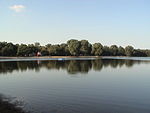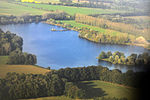Langenhagen Pferdemarkt station

Langenhagen Pferdemarkt station (Langenhagen (Han) until 27 May 2000) is a station in the town of Langenhagen, which lies north of Hanover, the capital of the German state of Lower Saxony. At present it is served by lines S4 and S5 of the Hanover S-Bahn. It was opened as Langenhagen station in 1890 and was the only station in Langenhagen in the first half of the 20th century. Three extra stations have been built since because of the growth of Langenhagen and the development of Hannover Airport. Since regional and long-distance services now only stop in the neighbouring Langenhagen Mitte station, Pferdemarkt station is now only served by S-Bahn services.
Excerpt from the Wikipedia article Langenhagen Pferdemarkt station (License: CC BY-SA 3.0, Authors, Images).Langenhagen Pferdemarkt station
Bahnhofsplatz,
Geographical coordinates (GPS) Address Nearby Places Show on map
Geographical coordinates (GPS)
| Latitude | Longitude |
|---|---|
| N 52.45067 ° | E 9.73628 ° |
Address
Langenhagen Lf
Bahnhofsplatz
30853 , Silberseesiedlung (Langenhagen (Kernstadt))
Lower Saxony, Germany
Open on Google Maps








